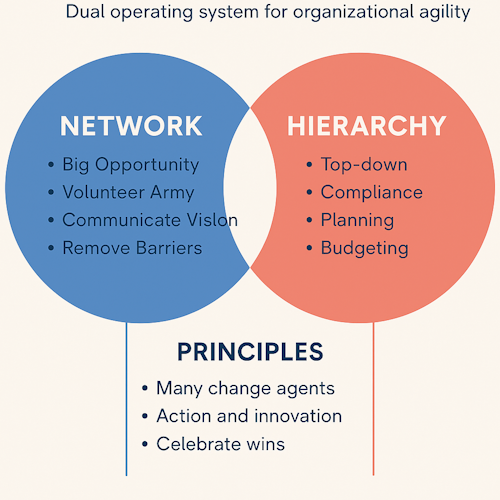Kotter's XLR8 Framework
Accelerate strategic change without slowing down delivery.
"The hierarchy is not going away. But it can no longer do everything." 1

The XLR8 Framework, developed by John P. Kotter, is a response to the growing realization that traditional hierarchical structures alone cannot keep pace with the speed of change in today's complex business environment. Originally introduced in his book Accelerate: Building Strategic Agility for a Faster-Moving World, the model emphasizes the need for dual operating systems within organizations: one focused on execution (the hierarchy) and one focused on innovation and adaptability (the network). Agile organizations resonate deeply with this model because they, too, aim to balance structure and speed. The XLR8 Framework provides a clear roadmap for embedding agility into strategy execution, innovation cycles, and cultural transformation.
Impact on Agile Organizations
When implemented well, the XLR8 Framework can significantly amplify an organization's adaptive capacity, strategic alignment, and cross-functional collaboration. However, without thoughtful integration, it may become a disconnected initiative or be absorbed and diluted by the traditional hierarchy.
- Strategic Agility Benefits:
- Encourages distributed leadership and decision-making.
- Enables faster validation of new ideas.
- Supports broad engagement with change.
- Challenges in Agile Contexts:
- Resistance from middle management fearing loss of control.
- Confusion between network activities and Scrum/Agile team responsibilities.
- Parallel systems may compete for time and attention.
- Organizational Misalignment:
- Agile teams may operate with speed, but without strategic linkage to enterprise goals.
- Network efforts may lose sponsorship if not tied to measurable impact.
Scenario
An enterprise-scale technology company trying to adopt Agile across all product lines. While Scrum is rolled out at the team level, strategic transformation efforts remain locked in quarterly steering committees and top-down planning. A few visionary leaders decide to introduce the XLR8 Framework to complement the Agile rollout:
- They identify change agents across departments.
- A volunteer network forms around strategic initiatives.
- These "Big Opportunity" teams prototype future-state customer journeys and test ideas quickly.
Initially, momentum builds. Yet friction emerges:
- Functional leaders question where authority lies.
- Agile team events and network meetings overlap.
- There's no integration into OKRs or formal funding.
Momentum slows, and the network gradually loses influence. Leadership realizes the XLR8 Network must be deliberately aligned with Agile Portfolio Management and delivery rhythms.
Ways to Mitigate Common Pitfalls:
To ensure the XLR8 Framework supports rather than competes with Agile transformation, organizations should align the network and hierarchy intentionally.
- Leadership Alignment:
- Ensure executive sponsorship links network strategy to organizational goals.
- Integrate Agile coaches and transformation leaders into the network.
- Role Clarity:
- Define how roles in the network relate to those in the Agile delivery structure.
- Identify "dually positioned" individuals who can bridge hierarchy and network.
- Integration Points:
- Use planning events (e.g., PI Planning in SAFe) to reflect on network progress.
- Align funding and KPIs with both strategic bets and Agile team outcomes.
- Communication & Feedback:
- Promote transparency across both systems using common tools (e.g., digital boards, showcases).
- Evolve participation models, start with volunteers, then invite rotational participation.
Conclusion:
The XLR8 Framework offers Agile organizations a powerful lens for scaling change beyond team-level practices. It builds upon Kotter's 8 Steps for Change but takes transformation from a one-time effort to a continuous way of operating. For Agile leaders, it can serve as the connective tissue between localized team agility and enterprise-wide adaptability. However, success depends on intentional design, leadership reinforcement, and clear integration with delivery structures.
Key Takeaways
- The XLR8 Framework is a dual operating model for agility and execution.
- It complements Agile by expanding change capacity and strategic alignment.
- Without integration, it risks becoming a side initiative.
- Strong leadership, role clarity, and aligned cadence are key to success.
- Communication between network and hierarchy ensures resilience and coherence.
Summary
In Agile organizations, the XLR8 Framework enhances responsiveness by introducing a parallel network for strategic adaptation. This network empowers volunteers to drive change while the hierarchy maintains operational execution. The model works best when it is embedded into the existing Agile operating rhythm, supported by leadership, and used to amplify cross-functional strategy rather than duplicate delivery work. It is not a replacement for Agile - it is a force multiplier.